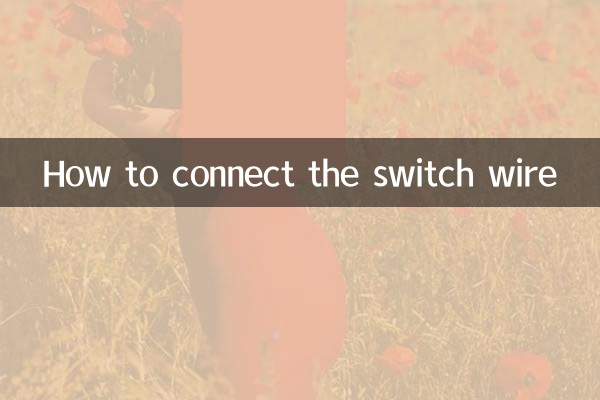How to connect the switch wire
In daily life, the correct connection of switch wires is one of the basic skills for home circuit installation and maintenance. Whether you're replacing an old switch or installing a new one, proper wiring not only ensures safe electrical use, but also prevents short circuits or electrical damage. This article will combine the hot topics and hot content on the Internet in the past 10 days to introduce you to the connection method of switch wires in detail and provide structured data for reference.
1. Basic principles of switch wire connection

The main function of the switch is to control the on and off of the circuit. In household circuits, switches are often used to control light fixtures or other electrical devices. The connection of switch wires needs to follow the following basic principles:
1.Power off operation:Be sure to turn off the power before wiring to ensure safety.
2.Distinguish between live and neutral wires: The live wire (L) is the live wire, the neutral wire (N) is the return wire, and the ground wire (PE) is used for protection.
3.Single and double control switches: Single control switch is used to control one lamp, and double control switch is used to control the same lamp in two positions.
2. Wiring method of single control switch
Single control switch is the most common type of switch. The wiring method is as follows:
| Wiring steps | Operating Instructions |
|---|---|
| 1. Power outage | Turn off the main power switch to ensure no power operation. |
| 2. Identify the live line | Use a voltage tester to detect the live wire (usually red or brown). |
| 3. Connect the live wire | Connect the live wire to the L terminal of the switch. |
| 4. Connect the lamp wires | Connect the other terminal of the switch to the live wire of the light fixture. |
| 5. Connect the neutral line | Connect the neutral wire directly to the N terminal of the lamp. |
3. Wiring method of double control switch
Dual control switches are suitable for scenarios where the same light fixture needs to be controlled in two locations, such as stair lights. The wiring method is as follows:
| Wiring steps | Operating Instructions |
|---|---|
| 1. Power outage | Turn off the main power switch to ensure no power operation. |
| 2. Identify the live line | Use a voltage tester to detect the live wire (usually red or brown). |
| 3. Connect the first switch | Connect the live wire to the L terminal of the first switch, and connect the two control wires between the two switches. |
| 4. Connect the second switch | Connect the L terminal of the second switch to the light fixture's live wire. |
| 5. Connect the neutral line | Connect the neutral wire directly to the N terminal of the lamp. |
4. Frequently Asked Questions and Solutions
In actual operation, you may encounter the following problems:
| question | Solution |
|---|---|
| The switch cannot control the light fixture | Check whether the live wire is connected to the L terminal of the switch and whether the lamp wire is connected correctly. |
| Switch heats up | Check whether the wiring is loose and whether the load is too large. |
| Light fixture flickers | Check whether the neutral wire and live wire are connected reversely, or whether the switch is damaged. |
5. Safety precautions
1.Power off operation: The power must be turned off at any time before wiring.
2.Use qualified tools: Make sure to use well-insulated tools and materials.
3.avoid overload: The switch and wires need to match the load power.
4.Professional assistance: If you are not sure about the operation steps, it is recommended to contact a professional electrician.
Summarize
The correct connection of switch wires is an important guarantee for the safety of home circuits. Through the introduction of this article, you should have a clear understanding of the wiring methods of single control switches and double control switches. In actual operation, be sure to follow safety regulations and ensure that every step is correct. If in doubt, seek professional help promptly.

check the details

check the details